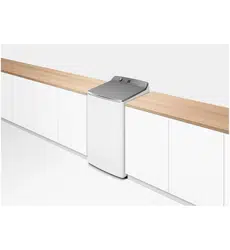Loading ...
Loading ...
Loading ...

34
TROUBLESHOOTING
Wash problems
PROBLEM POSSIBLE CAUSES WHAT TO DO
Detergent residue Overloading the washer. Try reducing your load size.
Incorrect detergent dosage. Try using less detergent.
Check the detergent instructions.
Cold ambient temperatures,
cold washes and/or short
agitation times may not allow the
detergent to dissolve properly.
Try pre-dissolving the detergent before
adding it to the washer.
Try using a liquid detergent.
Black or grey marks
on clothes
A build up caused by the
interaction of fabric softener
and detergent can flake off and
mark clothes.
Empty washer and put through a
DRUM CLEAN cycle.
If you use fabric softener, thinner
consistencies work better, try diluting it.
Insufficient detergent for the
amount of soil on the clothes, can
result in grey marks on clothes.
Make sure you are using enough detergent
for the amount of dirt in your wash load.
Dye transfer Washing dark coloured and light
coloured items together.
Remember to separate whites and colours.
Non-colourfast clothes left sitting
in a washer or laundry basket can
transfer dye onto other clothes.
Wash and dry non-colourfast
clothes separately.
Sheets and
duvet / doona covers
tangling or engulfing
each other
Wash cycle selected is not the
most appropriate.
Wash sheets and duvet / doona covers on
their own on the
SHEETS cycle.
Incorrect loading. Place sheets and duvet / doona covers into
the drum individually, to the side of the low
profile agitator (ensure each item does not
cover more than half of the drum area).
Load the items in layers around the drum
(2 sheets or duvet / doona covers per layer).
Ensure duvet / doona covers are buttoned
or domed closed before washing.
Bulky items very wet
at end of cycle.
Default spin speed of Bulky cycle
is
SLOW to best care for all bulky
items.
Check the load is suitable to be spun at a
higher speed and select
MEDIUM spin speed
prior to cycle start. Alternatively at the end
of the cycle, select
SPIN, then MEDIUM (MED)
spin speed. Ensure items sit below the top
of the lint filters beforehand and press
to
remove more water from the load.
Items feel very wet at
end of cycle, or are
wetter than expected.
The default spin speed of a
number of cycles is lower, i.e.
SLOW to best care for items
washed on those cycles.
Select a higher spin speed, if available on
the cycle. Check load is suitable to be spun
at a higher speed.
At the end of the cycle, select SPIN and
a higher spin speed (if available). Note:
ensure the items can withstand a higher
spin speed.
Loading ...
Loading ...
Loading ...
